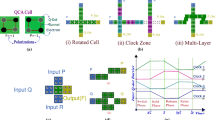Abstract
The concept of clocking for QCA, referred to as the four-phase clocking, is widely used. However, inherited characteristics of QCA, such as the way to hold state, the way to synchronize data flows, and the way to power QCA cells, make the design of QCA circuits quite different from VLSI and introduce a variety of new design challenges. The most severe challenges are due to the fact that the overall timing of a QCA circuit is mainly dependent upon its layout. This issue is commonly referred to as the “layout = timing” problem. To circumvent the problem, a novel self-timed circuit design technique referred to as the Locally Synchronous, globally asynchronous design for QCA has been recently proposed. The proposed technique can significantly reduce the layout–timing dependency from the global network of QCA devices in a circuit; therefore, considerably flexible QCA circuit design is be possible. Also, the proposed technique is more scalable in designing large-scale systems. Since a less number of cells is used, the overall area is smaller and the manufacturability is better. In this paper, numerous multi-bit adder designs are considered to demonstrate the layout efficiency and robustness of the proposed globally asynchronous QCA design technique.








Similar content being viewed by others
References
Antonelli DA, Chen DZ, Dysart TJ, Hu XS, Kahng AB, Kogge PM, Murphy RC, Niemier MT (2004) Quantum-dot cellular automata (QCA) circuit partitioning: problem modeling and solutions. The 41st Design Automation Conference (DAC), June
Choi M, Park N (2005) Locally synchronous, for quantum-dot cellular automata (LSGA QCA). IEEE International Conference on Nanotechnology, pp 121–124, July
Choi M, Choi M, Patitz Z, Park N (2006) Efficient and robust delay-insensitive QCA (quantum-dot cellular automata) design. IEEE International Symposium on Defect and Fault Tolerance in VLSI Systems 2006, pp 80–88, October
Choi M, Patitz ZD, Jin B, Tao F, Park N, Choi M (2007) Designing layout-timing independent quantum-dot cellular automata (QCA) circuits by global asynchrony. J Systems Archit (JSA) 53:551–567
Imre A, Csaba G, Ji L, Orlov A, Bernstein GH, Porod W (2006) Majority logic gate for magnetic quantum-dot cellular automata. Science 311(13):205–208, January
International Technology Roadmap for Semiconductors (2004) International technology roadmap for semiconductors (ITRS) 2004. http://public.itrs.net
Kummamuru RK, Orlov A, Ramasubramaniam R, Lent C, Bernstein G, Snider G (2003) Operation of a quantum-dot cellular automata (QCA) shift register and analysis of errors. IEEE Trans Electron Devices 50:1906–1913
Lent C, Isaksen B (2003) Clocked molecular quantum-dot cellular automata. IEEE Trans Electron Devices 50:1890–1896
Niemier M, Kogge P (2001) Problems in designing with QCAs: layout equals timing. Int J Circuit Theory Appl 29:49–62
Niemier MT (2000) Designing digital system in quantum cellular automata. MS CSE Thesis, Univ of Notre Dame, April
Orlov A, Kummamur R, Ramasubramaniam R, Lent C, Bernstein G, Snider G (2003) Clocked quantum-dot cellular automata shift register. Surf Sci 532:1193–1198
Orlov A, Kummamuru R, Ramasubramaniam R, Lent C, Bernstein G, Snider G (2002) A two-stage shift register for clocked quantum-dot cellular automata. J Nanosci Nanotechnol 2:351–355
Rojas F, Cota E, Ulloa S (2004) Magnetic field and dissipation effects on the charge polarization in quantum cellular automata. IEEE Trans Nanotechnol 3:37–41
Snider G, Orlov A, Amlani I, Bernstein G, Lent C, Merz J, Porod W (1999) Quantum-dot cellular automata. Microelectron Eng 47:261–263
Toth G, Lent C (1999) Quasiadiabatic switching for metal-island quantum-dot cellular automata. J Appl Phys 85:2977–2984
Yuan JS, Kuang W (2004) Teaching asynchronous design in digital integrated circuits. IEEE Trans Ed 47(3):397–404
Author information
Authors and Affiliations
Corresponding author
Additional information
Responsible Editor: N. A. Touba
This work is an extension of the paper presented at IEEE DFT06.
Rights and permissions
About this article
Cite this article
Choi, M., Choi, M. Scalability of Globally Asynchronous QCA (Quantum-Dot Cellular Automata) Adder Design. J Electron Test 24, 313–320 (2008). https://doi.org/10.1007/s10836-007-5052-0
Received:
Accepted:
Published:
Issue Date:
DOI: https://doi.org/10.1007/s10836-007-5052-0




